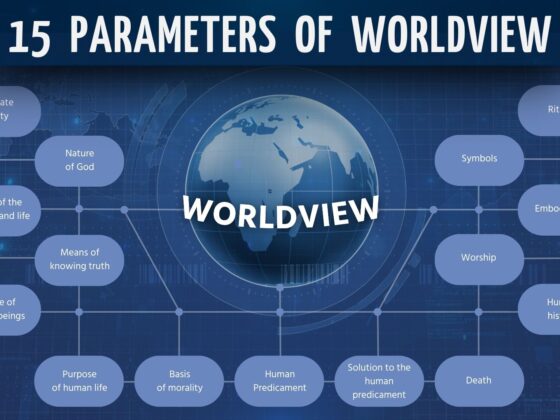Why Teach a Biblical Worldview?
October 10, 2023
Katherine Schultz
There is a bit of a debate within Christian circles about whether or not to teach a biblical worldview. Why teach it? Why might someone object to teaching a biblical worldview?
Why NOT teach a Biblical Worldview?
There are three ideas that seem to sum up the reasons someone would object to teaching a biblical worldview:
- Teaching a biblical worldview makes the gospel merely intellectual, making it humanistic
- Teaching a biblical worldview can separate a person’s life from scripture, making it irrelevant
- Teaching a biblical worldview turns the gospel subject to each individual, making it relativistic
Let’s address each of these objections from a 3-Dimensional Worldview perspective. At 3-D Worldview Survey, we believe that a worldview has 3 dimensions (I’m sure you saw that coming): beliefs, behaviors, and attitudes. We see those dimensions as directly addressing the possible objections to teaching a biblical worldview.
Don’t Make the Gospel Humanistic: Teach Biblical Worldview Beliefs
The first challenge to address is whether teaching a biblical worldview overemphasizes reason or the mind. It elevates the intellect.
It is true that a person can be an “enlightened sinner,” knowing all there is to know, but putting none of it into effect in his or her life. And in fact, James 2:19 warns us that even the demons believe there is a God.
But there is also a place for understanding sound doctrine, and knowing the word of God well enough that it serves one of its purposes: to arm and defend the believer (Ephesians 6:10-18). The critical difference is whether a person elevates the word of God over reason, or reason over the word of God. If reason has higher authority, it will certainly result in a humanist worldview, but if the word of God has higher authority, then reason is subject to God and his truth, and will be a servant rather than a master.
In addition, if a person doesn’t have a firm hold on the truth (biblical knowledge and an understanding of sound doctrine), then it is much easier for that person to be drawn away from truth, to be deceived or confused. Trevin Wax says, “If we are to embrace a worldview formed by the drama of Scripture, we must return again and again to the true story of our world in order to have our own blind spots exposed and mistaken ways corrected.”
So a person’s beliefs are a critical component of his or her worldview. But they are not the entirety of it, and if the demons believe (and tremble, James 2:19), then belief alone cannot save a person. But if we want the people of God to have biblical knowledge, we do need to teach biblical worldview beliefs thoroughly.
Don’t Make the Gospel Irrelevant: Teach Biblical Worldview Behaviors
Another challenge to address is making the gospel irrelevant by the teaching of biblical worldview. In addition to a person’s beliefs, a person’s behaviors are a critical component of his or her worldview. And our behaviors and beliefs are profoundly interconnected. According to James K. A. Smith, “Instead of a trickle-down approach that begins with beliefs and then moves toward desires and actions, Smith sees the reverse taking place; human practices contribute to their imaginations, which then lead to the formation of knowledge of doctrines. He adds, ‘What we do (practices) is intimately linked to what we desire (love), so what we do determines whether, how, and what we can know.’”
We need to encourage believers to put into practice what they know and believe. And we need to encourage them to act and behave in a way that strengthens their biblical beliefs. Consistently behaving in accordance with the Bible will have a formative effect on a person’s beliefs, and will make a person less vulnerable to being “tossed back and forth by the waves, and blown here and there by every wind of teaching and by the cunning and craftiness of people in their deceitful scheming” (Ephesians 4:14).
According to Trevin Wax, “The reality is neither a trickle-down approach, like a river that rushes from knowledge to beliefs to practices; neither is it a trickle-up approach leading from practices to imagination to knowledge. Instead, we should view the relationship between the imagination and knowledge more like ocean waves, where the ocean thrusts water onto the shore (our practices) and the water that returns is taken up into the sea (our beliefs) and becomes part of the next wave (knowledge that now encompasses beliefs and practices).”
To be clear, I am not saying that a person is saved by his or her behaviors, any more than I would say that a person’s beliefs alone will save (remember even the demons believe). But we do need to teach biblical worldview beliefs, and encourage biblical worldview behaviors. But again, there is more to worldview than beliefs and behaviors.
Don’t Make the Gospel Relativistic: Teach Biblical Worldview Attitudes through Heart Orientation
There is a third objection to teaching a biblical worldview, that it becomes entangled with modern culture and thereby becomes relativistic. This might be the result of a person’s growing awareness of the wide range of worldviews that exist, and the realization that even believers have varying worldviews, some more biblically aligned than others. Wilkens and Sanford call these “hidden worldviews.”
But teaching a 3-dimensional biblical worldview includes beliefs, behaviors, and attitudes: it includes what James Sire calls the orientation of the heart. In a nod to Augustine, Smith believes, “The way we inhabit the world is not primarily as thinkers, or even believers, but as more affective, embodied creatures who make our way in the world more by feeling our way around it.” And at 3DWS, we believe heart orientation has 4 parameters: worship, embodiment, symbol, and ritual. All of these work together as part of a 3-dimensional worldview to help a person have a mature, biblical worldview.
Recognizing the diversity in God’s creation doesn’t negate the unity of His truth, and for believers to have a mature biblical worldview, they need a 3-dimensional worldview that aligns their beliefs, behaviors, and attitudes with the Bible. Variations in worldview may or may not stay within biblical bounds, but a person’s heart orientation is certainly a critical component of his or her worldview.
For more information on objections to teaching worldview, and a biblical grounded response, see this Gospel Coalition Article.
So Why Teach a Biblical Worldview?
Here is a quick summary of reasons:
- Eternity! We should teach a biblical worldview because we are dealing with eternal souls. Preparing those souls, and our own, should be a high priority.
- Here and now, not only eternity. We should teach a biblical worldview because we live not only for eternity, but also in the here and now, and should do so in a manner consistent with the Bible.
- The training of the remnant. Because God will preserve His church! It’s desperately needed! So few self-proclaimed Christians have a biblical worldview
- Firm foundation. We want our students, and ourselves, to have a firm foundation from which all life is understood and lived–beliefs, behaviors, and attitudes.
- Paideia. A Biblical worldview forms a framework for thinking, doing, being, relating to anything.
- Avoid enlightened sinners. We need all three dimensions of a worldview because we want to avoid producing enlightened sinners, people who know it all, but live none of it, or have destructive attitudes, and resistant hearts.
- Avoid emphasizing only one component of worldview by teaching all 3 dimensions of worldview. Having an unbalanced perspective on worldview has dangers whether the particular dimension is the highest or the lowest.
Now What?
As Trevin Wax points out, “Smith’s criticism of an approach to spiritual formation that is overly intellectualized is a helpful caution against focusing only on the cognitive aspect of worldview formation. However, as long as we remain fully aware of the ‘affective’ and ‘moral’ dimensions of a worldview, as noted by Paul Hiebert and as affirmed by N. T. Wright in his consideration of cultural symbols as expressions of practice, then we should be able to avoid many of the dangers Smith mentions. (I agree with Wright, who says we should “expand the notion of worldview to incorporate these and other elements rather than abandon it and launch out with a different term.”)” And I agree with both of them. We need a 3-dimensional concept of worldview.
Again, from Trevin Wax, “As long as we are clear on the affective and imaginative elements of worldview formation (as opposed to what is primarily a cognitive approach), the biblical drama as the true story of the world (as opposed to the relativizing tendencies of a pluralistic diversity of worldviews), and the need to be constantly immersed in Scripture (as opposed to extrabiblical or antibiblical visions of the world), then we can continue to use the idea of worldview as a way of helping to understand the interpretive framework from which people know, believe, and act in the world.”
Knowledge and beliefs. Actions and behaviors. Attitudes and heart orientation.
Instead of making the gospel humanistic, irrelevant, or relativistic, let’s teach a 3-Dimensional Worldview, addressing beliefs, behaviors and attitudes.
A great place to start is knowing where your students are in their worldview.
- What Is the 3-D Worldview Survey?
- Take the 3-D Worldview for yourself
And if you haven’t yet used the 3-D Worldview Survey with your class, check out the pdf below for some questions to get you started.
#3dworldview #biblicalworldview #teachingworldview





